 Be Inspired Blog - Arizona
Be Inspired Blog - Arizona

Why Do Spring-Flowering Bulbs Need to Be Planted in Fall?
Late summer is the perfect time to start thinking about spring-flowering bulbs since we're approaching the time to plant them. While gardeners in other parts of the country are already getting their start on their fall-planted, spring-blooming bulbs, here in Arizona, we still have a couple months before we need to put them in the ground. That means late summer/early fall is the ideal time to get your hands on some of the top bulbs to grow here—available seasonally, while supplies last!
Why Plant Spring-Flowering Bulbs in Fall
Fall-planted bulbs need to be in the ground during cooler months since they require a chilling period to stimulate growth, a process called vernalization. In the spring, the vernalization period ends and the bulbs burst into action, and you're treated with a landscape full of vibrant blooms. Vernalization not only improves flower size and abundance but also helps with the plant's overall health, like resistance to disease.
In Arizona, many bulbs can be planted in the garden once temperatures drop below 90˚F, whereas a few, like bearded iris or edible bulbs like garlic, can go in a little earlier. However, our temperatures don’t drop low enough for certain bulbs to vernalize, so we need to chill these bulbs ourselves. Tulips, hyacinths, and crocus bulbs should be purchased now and placed in your fridge in the crisper drawer or in a mesh bag for eight to ten weeks. (Make sure the bulbs are kept away from fruits and veggies, like bananas, apples, pears, peaches, and melons. Some produce emits ethylene gas that can harm the bulb.) Once the chilling period is up, you can then plant them in your garden during November or December, and they’ll greet you with phenomenal flowers in the springtime!
Tips for Planting Bulbs
Generally, bulbs prefer full sun and well-draining soil. Working compost into the soil can help with drainage plus adds nutrients.
Planting
Once you choose your location and have amended the soil, it's time to dig the hole. A general rule is that the depth should be three times the bulb's height, though double-check the bulb's tag as this can differ between bulbs. After digging each hole, place the bulb in with its pointed side facing up. Fill in the hole with soil, then repeat the whole process until you've planted all the bulbs. Leave enough space in between bulbs to avoid crowding; the same rule of thumb for planting depth (three times the bulb’s length) generally also applies to bulb spacing. For example, smaller bulbs like crocus do best with 3-4 inches of space between them, and larger bulbs like hyacinths and daffodils do better with 6-8 inches of space.
Fertilizing & Watering
While burying the bulbs, mix a bulb food like EB Stone Organics Bulb Food into the soil. This fertilizer will slowly release nutrients for the bulb to absorb, leading to brighter, bigger, more vigorous flowers.
Bulbs look best when planted in groups and in a random order rather than straight lines. This creates the most natural look, but of course, the garden design is all up to you, so feel free to use your creativity! Once the bulbs are happily in their homes, water the soil well, but avoid watering too often afterward. Too much moisture can cause bulbs to rot, so it’s best to go light on watering until they begin to sprout.
After the bulbs are securely in the ground, you may be tempted to forget about them until spring. However, there’s one more major threat to your bulb’s safety: critters! Bulbs are rich in starch and sugars, and rodents like gophers and rabbits love to dig them up. If these animals are common in your yard, you can plant your bulbs in a wire cage that goes in the ground, which will protect them from any hungry critters. You can also use a repellent product, like Bonide Repels-All, to deter scavengers from munching on your bulbs.
Growing Bulbs in Pots
Bulbs can also be grown in pots, which can make for an adorable indoor or outdoor display in the springtime! Follow the same rules of thumb for planting depth, spacing, and watering as you would in the garden, planting bulbs in layers according to the necessary planting depth. Use a potting medium like E.B. Stone Organics Rose Grow Planting Mix, which is rich in the nutrients that bulbs need to develop beautifully. By combining several bulb varieties in your containers, you’ll enjoy a living floral arrangement next year that blooms continuously for months. These containers are so delightful, they might just become an annual tradition!

Best Spring-Flowering Bulbs for Arizona Gardens
Flowering bulbs come in a range of sizes and colors, so you're sure to find one (or many!) suitable for your garden. Here are a few of our favorites:
- Allium
- Anemone
- Crocus
- Daffodil
- Grape Hyacinth
- Hyacinth
- Iris
- Ranunculus
Bulbs have a way of adding color and vibrancy to your garden unlike any other plant. We have spring-flowering bulbs available now, so stop by one of the Arizona SummerWinds locations to pick some up!



